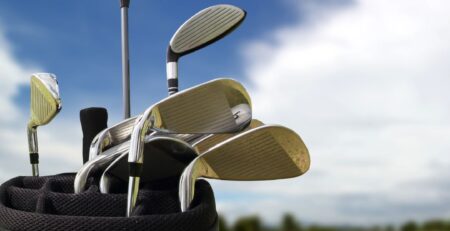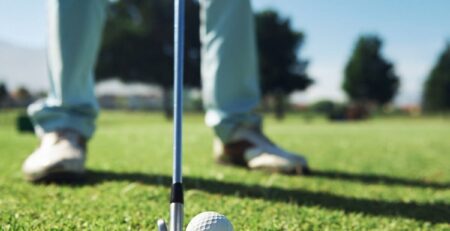Golf Club Fitting: What to Expect and How to Prepare
Are you tired of hitting the golf course with ill-fitted clubs? Do you want to improve your game and take it to the next level? If so, then golf club fitting might be just what you need.
Properly fitted golf clubs can make all the difference in your swing and performance on the course. Here we explore everything you need to know about golf club fitting – from why it’s important, to what to expect during a fitting session.
The importance of golf club fitting
Golf club fitting is the process of matching golf clubs to a golfer’s physical attributes and swing characteristics. It may seem like an unnecessary expense, but in reality, it can make a huge difference in your game.
One of the main reasons why golf club fitting is so important is that everyone’s body and swing are different. A set of clubs that work for one person might not be suitable for another. Golfers who use ill-fitted clubs often find themselves struggling with consistency, distance, accuracy issues and other problems.
Golf club fitting ensures that you have the right equipment tailored to your specific needs as a player. This means that you will be able to get the most out of each shot and play more consistently throughout your round.
In addition to improving performance on the course, properly fitted golf clubs can also help prevent injury by reducing stress on joints from using incorrect equipment or compensating for poor fit during swings.
Investing in proper golf club fitting is essential if you want to improve your game while minimising risk of injury.
Benefits of proper golf club fitting
Proper golf club fitting is essential for any golfer, regardless of skill level. The benefits of having clubs that are fit to your body and swing are numerous. First, properly fitted clubs can improve your accuracy and consistency on the course. This means fewer shots off target and more confidence in your game.
In addition, proper golf club fitting can also help prevent injury by ensuring that you aren’t putting unnecessary strain on your muscles or joints with each swing. This is especially important for older or less physically fit golfers who may be prone to injury.
Another benefit of proper golf club fitting is increased distance on your shots. When the shaft length, flex, and head design match your swing style and physical attributes, you’ll be able to generate more power with less effort.
Investing in a professional golf club fitting session will not only improve your game but also make it more enjoyable. You’ll have peace of mind knowing that you’re using equipment optimised for you specifically rather than relying on generic off-the-shelf options.
How ill-fitted golf clubs can affect your game
Having ill-fitted golf clubs can significantly impact your game. Golfers who use clubs that are not suited to their swing and body type may struggle to hit the ball accurately, leading to frustration and disappointment on the course.
One way in which a poorly fitted club can affect your game is by causing inconsistency in your shots. If the club isn’t properly balanced or sized, you may find it challenging to strike the ball consistently, resulting in less accuracy and distance.
Another common issue with ill-fitted clubs is that they can cause unnecessary strain on your body during play. The wrong length or weight of a club could lead to an uncomfortable grip or swing motion that places undue stress on areas such as your wrists, shoulders, or back.
Additionally, using clubs that don’t fit well also means missing out on potential performance gains. A custom-fit driver might allow you to add extra yards off each tee shot while providing more control over spin rates and launch angles.

Benefits of properly fitted golf clubs
Properly fitted golf clubs can make a significant difference in your game. When you have the right club length, weight, and flex that match your swing, you will be able to hit more consistent shots with better accuracy.
One of the benefits of properly fitted golf clubs is increased distance. With a correctly fitted driver, for instance, you can maximise your driving potential by optimising launch angle and spin rate. This means you’ll get more yards off the tee with less effort.
Another benefit is improved ball flight trajectory. The correct lie angle on your irons helps ensure that the clubface makes proper contact with the ball at impact. As a result, you’ll see fewer hooks or slices and instead achieve straighter shots.
Having well-fitted golf clubs also reduces fatigue during play as it requires less effort to use properly fit equipment than ill-fitting ones. Moreover , if players feel comfortable using their club set-up they are free of physical worries which enhances their mental focus while playing.
Properly fitted wedges allow for greater control around greens and can lead to more up-and-downs saving strokes on scoresheet . In addition fitting putters provide better alignment aid leading to better aiming abilities allowing players to hole out those much needed birdie putts .
The golf club fitting process
Golf club fitting is the process of customising golf clubs to fit an individual’s unique physical characteristics, swing style, and playing preferences. The goal of golf club fitting is to help golfers achieve their maximum potential on the course by optimising their equipment.
The first step in the golf club fitting process involves an assessment of the golfer’s physical attributes such as height, wrist-to-floor length, and hand size. This information is used to determine what type of clubs will best suit their needs.
Next, we will analyse the golfer’s swing. This allows us to identify areas where adjustments can be made to optimise performance.
Once all necessary data has been collected, we will recommend specific clubs that are customised based on factors such as loft angle, shaft length and flex, grip size and texture, among others.
It is important for golfers not only to rely on feel but also trust data-driven recommendations provided by our golf professionals who understand how different components interplay with each other during a swing.
Types of fitting tools and technology used
When it comes to golf club fitting, there are various types of tools and technology used. These tools help the fitter assess different aspects of your swing and determine the right specifications for your clubs.
One common tool is a launch monitor, which measures ball flight characteristics such as spin rate, launch angle, and ball speed. This information helps the fitter select the best shaft flex, loft, and other specifications for your clubs.
Another tool commonly used in club fitting is a lie board or lie angle machine. This tool helps measure the angle between the sole of the clubhead and the ground at impact. Based on this measurement, adjustments can be made to ensure that each club sits flush on the ground when you address it.
Weight scales are also important in determining proper weighting for each individual golfer’s specific needs. Fitters use these scales to weigh various components of a golf club like its head or grip size so they can balance weight throughout all parts of their set according to their preferences.
What to expect during a fitting session
Once you’ve scheduled your golf club fitting session, it’s important to know what to expect during the process. A typical fitting session usually lasts about an hour and involves a series of measurements and tests to determine which clubs are best suited for your swing.
We will start by asking some questions about your game, including your handicap, average score, and preferred shot shape. They may also ask about any physical limitations or injuries that could affect your swing.
Next, they’ll take measurements of your height, arm length, hand size, and other relevant factors. These measurements help determine the optimal shaft length and flex for each club.
You’ll then be asked to hit balls with several different types of clubs while the fitter observes your swing. This helps them assess factors like launch angle, spin rate, ball speed, and accuracy.
Based on these observations and measurements, we can recommend specific club models that are well-suited for your individual needs. They may also make adjustments to things like lie angle or grip size in order to further fine-tune the fit of each club.
A fitting session is an important step towards improving your overall game performance through properly fitted equipment tailored specifically for you!
What to bring to a fitting session
Preparing for a golf club fitting session can be overwhelming. But knowing what to bring with you can make the process smoother and less stressful.
First, it’s important to wear comfortable clothing and shoes that allow you to move freely during your swing. Avoid wearing tight or restrictive clothes that may hinder your movement or affect your swing.
Next, bring along all the clubs currently in your bag, including irons, woods, hybrids and putters. This will give the fitter an idea of what type of clubs you’re accustomed to using and how they fit into your game.
You should also bring any specialised equipment such as gloves, hats or sunglasses that you typically use while playing golf. These items can affect how a club feels in your hand or on your head and impact how well you play.
It’s also helpful to have some basic knowledge about your current set up such as shaft flexes, loft angles and grip sizes so that the fitter can better understand where improvements need to be made.
Don’t forget water or snacks if needed during a long fitting session! Being hydrated and fuelled will ensure you perform at optimal levels throughout the entire process.
How to assess your golf game and swing
Assessing your golf game and swing is a crucial step in determining the right type of clubs that will fit your playing style. One way to evaluate your performance is by keeping track of important statistics such as fairways hit, greens in regulation, and average distance per shot.
It’s also important to consider any physical limitations or injuries that may impact your swing. For example, if you have limited flexibility due to back pain or arthritis in your hands, you may need modifications to the standard club length or grip size.
It’s essential to be honest about your skill level when assessing your golf game. If you’re a beginner or intermediate player who struggles with consistency on the course, choosing forgiving clubs with larger sweet spots and more loft can make a significant difference in improving accuracy and confidence.
Tips for communicating with the club fitter
When it comes to getting your golf clubs fitted, communication is key. It’s important that you are able to effectively communicate your needs and preferences in order to get the best possible results from your fitting session.
Firstly, be honest about any physical limitations or injuries that may impact your swing. This information will allow us to make adjustments accordingly and ensure that you are comfortable throughout the fitting process.
Secondly, don’t be afraid to ask questions! We are here to help you find the right equipment for your game, so take advantage of our expertise by asking for clarification on anything that isn’t clear.
Additionally, provide as much feedback as possible during the fitting session. If something doesn’t feel quite right or if a certain club doesn’t seem like a good fit for you, let us know. They can use this information to make further adjustments and recommendations.
By working together and communicating effectively, you can ensure that you walk away from your fitting session with clubs perfectly tailored for your game.
Factors to consider when selecting golf clubs
When it comes to selecting golf clubs, there are several factors that you need to consider. The first thing you need to take into account is your skill level. If you’re a beginner, then it’s recommended that you opt for game improvement clubs as they are more forgiving and easier to hit than other options.
Another factor to consider is the type of course on which you usually play. For example, if the majority of courses in your area have narrow fairways and small greens, then choosing irons with a higher loft can help improve your accuracy.
The shaft flex is also an important consideration when selecting golf clubs. The flex rating refers to how much the shaft bends during your swing. A softer flex will give you more distance but less control while a stiffer flex provides greater accuracy but less distance.
You should also think about clubhead size and weight when making your selection. Larger heads often provide more forgiveness while smaller heads offer better precision and control over shots.
It’s essential to keep cost in mind when selecting golf clubs since prices can vary greatly depending on brand name and customisations desired. However, investing in higher-quality gear may be worth it in the long run as they tend to last longer and perform better overall on the course.
Understanding club components and customisation options
Understanding the components of a golf club is essential to finding the perfect fit. The main components include the grip, shaft, and head. The grip is where you hold onto the club and it can be customised in terms of size, material, and texture. A good grip makes all the difference when it comes to control and consistency.
The shaft connects the grip to the clubhead and affects both distance and accuracy. It can be customised in terms of length, flex (the amount of bend), weight, and material. A properly fitted shaft will optimise your swing speed for maximum power without sacrificing control.
The clubhead is responsible for striking the ball and shaping its trajectory. Its customisation options include loft (angle), lie angle (how upright or flat it sits on ground), weight distribution (centre of gravity), face angle (closed/open) among others). Each option alters how easily you can hit certain shots while also affecting shot direction.
Customisation options vary by manufacturer but typically allow for adjustments within these three main categories: driver/woods/hybrids; irons/wedges; putters.
When choosing customisations consider factors like your height/weight/strength/flexibility etc., as well as your swing tendencies such as whether you tend to slice or hook your shots
Ultimately understanding each component will go a long way towards helping you understand what works best for your game so that you get clubs that complement rather than detract from it!
The benefits of custom-built golf clubs
Custom-built golf clubs are tailored to your specific needs and preferences, which makes them a valuable investment for any avid golfer. By customising the club’s components such as shaft length, weight, flex or grip size, you can optimise your swing performance and get better results on the course.
One of the main benefits of custom-built golf clubs is that they provide you with a more comfortable fit. Golfers who use ill-fitting clubs may experience discomfort or even pain during their swings, which can negatively impact their game in the long run. Custom-built clubs eliminate this issue by ensuring that every aspect of the club feels right in your hands.
Another benefit of custom-built golf clubs is increased accuracy and distance. With properly fitted equipment, you’ll be able to hit shots straighter and farther than ever before. A customised driver with an optimised loft angle could add significant distance to your drives while also reducing side spin for improved accuracy.
Customised irons offer another advantage: consistent ball striking. When all aspects of your iron set are matched precisely to your swing style, you’ll have more control over where and how far each shot goes – leading to lower scores!
Conclusion
Golf club fitting is a crucial step in enhancing your game and improving your overall experience on the golf course. By investing time and effort into proper club fitting, you can ensure that you are using the right equipment tailored to your unique swing style and body measurements.
So schedule an appointment, call us on 07522114514 or go to dandagolf.com/custom-fitting/ for more information.











